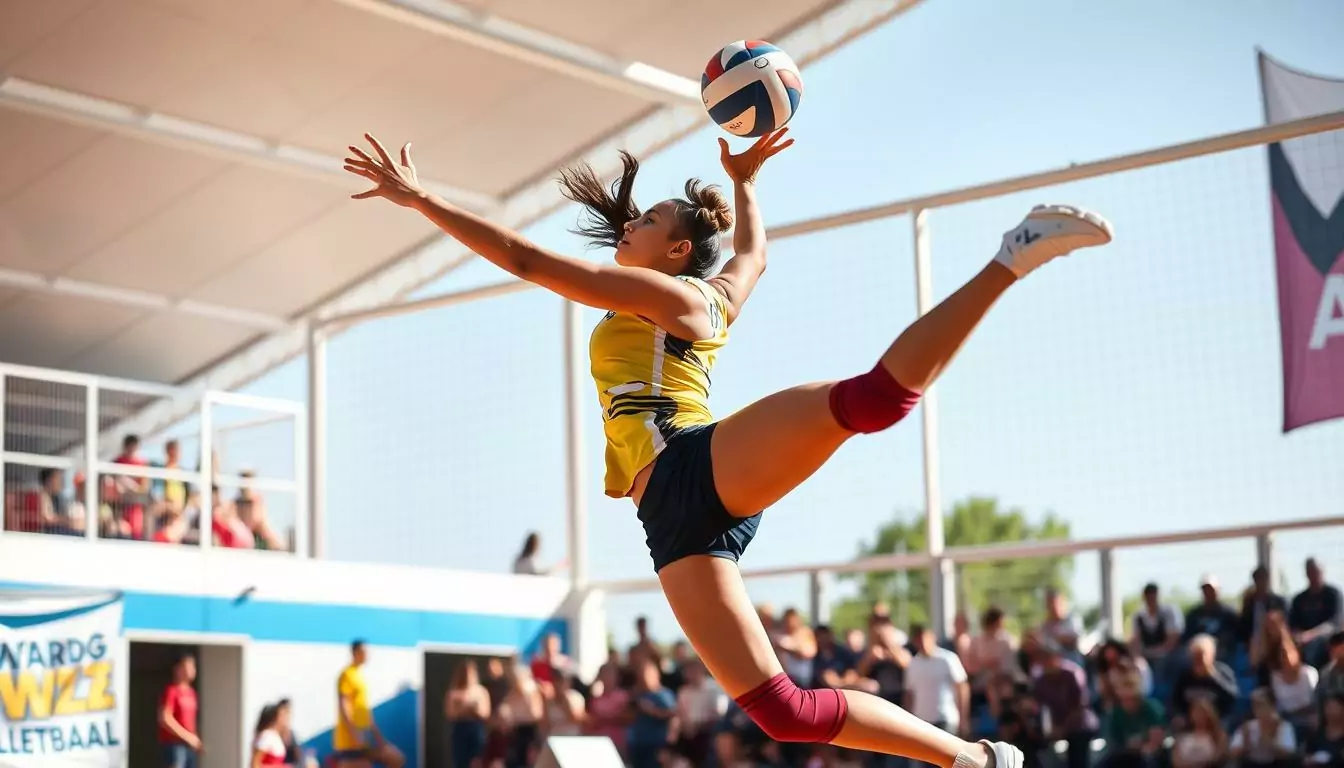Volleyball serves are like a kickoff in football or a pitch in baseball. They are the first contact that can change the game. International teams focus more on serving than American athletes, seen at the U-18 World Championships. Yet, college players have improved their serving skills, unlike club players who have not.
As a volleyball player, mastering the serve is key. It gives you a strategic edge on the court.
Key Takeaways
- Serving is the most important skill in volleyball, initiating every rally.
- Overhand serves offer greater power, control, and spin compared to underhand serves.
- Serving strategies focus on challenging the receiver’s positioning and readiness.
- Advanced serves like the topspin serve and float serve add further complexity.
- Serving drills and practice are key to developing consistent, powerful serves.
The article talks about two main types of serves: underhand and overhand. Beginners often start with the underhand serve. But, mastering the serve is vital, as it starts every play in volleyball. As players get better, they move from the underhand to the overhand serve.
There are two main types of serves: the float serve and the spin serve. Float serves are unpredictable, while spin serves offer more control. Elite competitions show that serves landing short or deep are more effective than side-to-side ones. Serving diagonally is also a strategic advantage.
Developing a signature serve, like a baseball pitcher’s fastball, is suggested for confident serving. It’s also important to have freedom in serving zones, not just follow coach’s orders. Tactics include using short and deep serves to challenge the receiver.
Practice drills should focus on serving, aiming for at least two successful serves before losing. Good servers are those who help the team score, either with aces or by disrupting the opponent.
The Fundamentals of a Powerful Serve
Mastering the volleyball serve is key to success. It involves several important elements, from the serving grip to the follow-through.
The serving grip is vital for power and control. Hold the ball with your non-dominant hand and strike it with your dominant hand. This grip helps for a smooth toss and solid ball contact.
The serving stance is also critical. Stand with your feet shoulder-width apart, with your non-dominant foot forward for balance. This stance helps you generate power and accuracy.
The toss is essential for a good serve. It should be high to allow a powerful hit. This ensures solid ball contact.
The contact point for an overhand serve is just above the waist. Your dominant hand should strike the ball flat and firm. This technique makes your serve powerful and accurate.
A good follow-through is key for control and power. Extend your arm fully and finish with your hand pointing at the target. This helps you control the ball’s direction.
By mastering these serve fundamentals, volleyball players can gain an edge. Techniques like overhand, float, and jump serves are essential for success.
Overhand Serve: Technique and Variations
The overhand serve is a key move in competitive volleyball. It offers more power, control, and spin, making it tough for the other team to handle. About 75% of serves in top-level matches are overhand, including topspin and float serves.
Topspin Serve
The topspin serve adds spin to the ball, making it drop and bounce unpredictably over the net. It’s a powerful tool when done right. When done well, a topspin serve can win points or make it hard for the other team to return. It’s the most common serve in competitive volleyball.
Float Serve
The float serve doesn’t spin much but wobbles in the air, making it hard to guess where it will go. It’s known for being hard to pass. In pro matches, float serves lead to about 30% of reception errors. It’s a jump serve used in both indoor and beach volleyball.
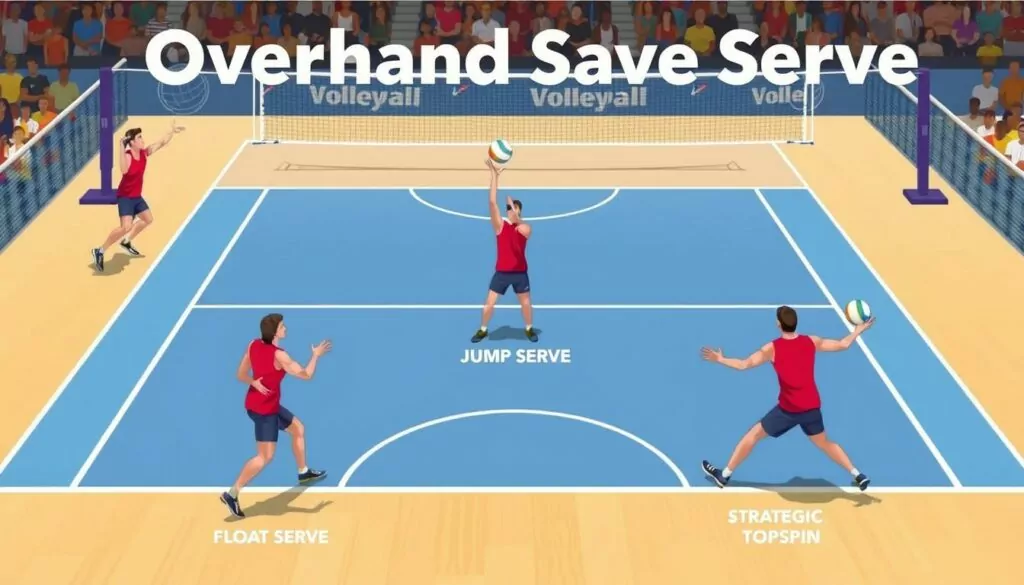
Practicing these serves regularly can give players a big edge. It’s key to keep practicing to get better at overhand serves.
| Serving Technique | Success Rate | Advantages |
|---|---|---|
| Topspin Serve | 80% | Unpredictable trajectory, hard to receive |
| Float Serve | 70% | Unpredictable movement, difficult to pass |
“Mastering the overhand serve, with its topspin and float variations, is key for any serious volleyball player. These techniques can change the game if done with precision and control.”
Knowing how to use these serving techniques can give volleyball players a big edge.
Jump Serve: Adding Power and Precision
The jump serve is a powerful move in volleyball. It combines a strong jump with an overhand serve. This makes the ball travel in a straight line, making it hard for the other team to return.
It’s different from a standing serve, which is more stable. The jump serve adds power and precision to the game.
The jump serve’s fast, downward path can make it hard for the other team to handle. This unpredictability can cause them to struggle with the ball’s movement.
On the other hand, the float serve makes the ball move erratically. This can also mess up the other team’s passing. The topspin serve, with its sharp dip, adds speed and control, making it great for advanced players.
The overhand serve is a key skill for more complex serves. It needs good hand-eye coordination and timing. A full arm swing from behind the head is essential for a good serve.
This serve balances power and control, making it popular at all levels. The underhand serve, with its low path, is easier to control but less challenging for the other team.
The serve is a key moment in volleyball. It can set the pace and direction of the game. Mastering the jump serve can make a big difference in the game.
Float Serve: Mastering the Art of Deception
The float serve is a captivating and deceptive technique that can change the game. It uses little spin, making the ball’s path hard to predict.
To master the float serve, you need power, control, and precision. Coaches say a clean ball contact and an elbow angle of about 110 degrees are key. Also, drills to strengthen your wrist and improve flexibility can help a lot.
The float serve’s trick is its little spin. This makes the ball wobble in the air, making it hard for the receiver to guess where it will land. Changing the ball’s speed and where you serve it can surprise the other team and help your team score.
Being consistent with the float serve is important. Knowing the difference between it and the topspin serve and avoiding common mistakes are key. Drills, balance exercises, and strength training can help you get better at the float serve.
The float serve’s unpredictability makes it a powerful tool for any volleyball team. By mastering the float serve, players can surprise the other team and create chances to score.
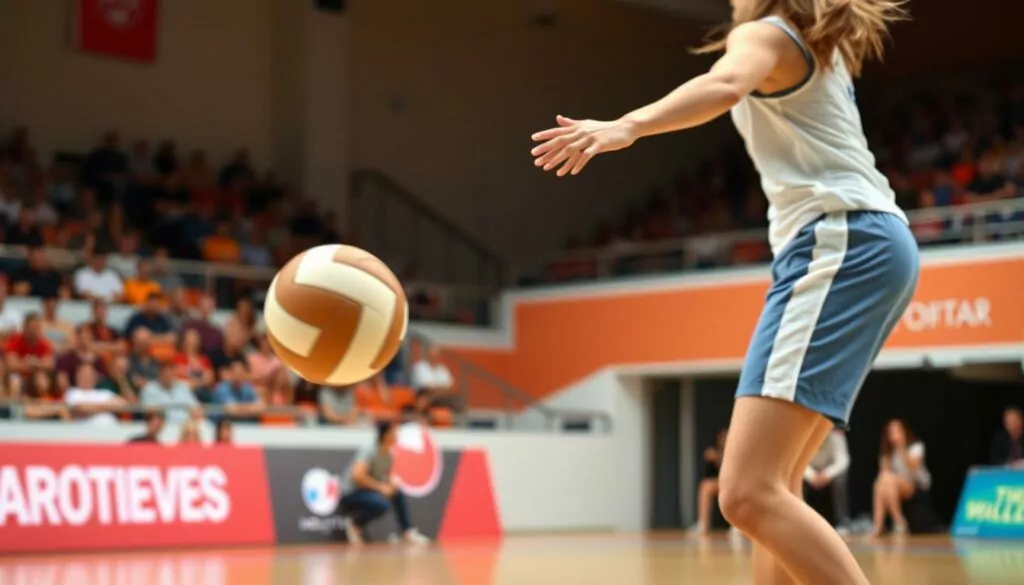
“The float serve is like a magic trick – it keeps the other team guessing and sets up scoring chances for your team.” – Coach Sarah Johnson
Serving Strategies for Different Game Situations
Serving is a key part of the game, with many tactics to gain an edge. Targeting the weaker receivers on the opposing team and aiming serves at them can disrupt their offense and put your team in control. Varying your serves between topspin, float, and different locations on the court keeps the receiving team guessing. This makes it harder for them to anticipate your next move. Serving to specific zones on the court, such as deep or short, can also be effective.
Maintaining consistency in your serves is key, as it’s more valuable than a single powerful serve that might be inconsistent. Communication with your teammates is also important, as it helps them position themselves correctly.
| Serving Tactic | Description | Benefit |
|---|---|---|
| Targeting Weak Receivers | Aiming serves at the opposing team’s weaker receivers | Disrupts the opponent’s offense and puts your team in control |
| Varying Serve Types | Mixing topspin, float, and different court locations | Keeps the receiving team guessing and makes it harder to anticipate your next move |
| Serving Specific Zones | Targeting deep or short areas of the court | Can be an effective strategy to disrupt the opponent’s offense |
| Serving Consistency | Ability to consistently place serves where intended | More valuable than a single powerful but inconsistent serve |
| Communication | Informing teammates of serving intentions | Helps teammates position themselves correctly |
The progression of serving techniques in training includes starting with underhand serves, then advancing to overhand float serves and eventually experimenting with jump floats as players get stronger and more skilled. Strategies for second serves aim at putting experienced opponents out of system, which may include increasing velocity, delivering float serves with minimal spin to make it harder to pass, executing jump spinning serves (hitting with velocity is key), jumping float serves (common at higher levels due to the downward trajectory and difficulty to track by receivers), and varying depth with short or deep serves to disrupt the opponent’s rhythm.
“Serving under pressure in game situations is key for players to develop their skills beyond repetitive practice.”
By using these serving strategies and tactics, players can gain a competitive edge. This disrupts the opposing team’s offense, increasing their chances of success in the game.
Common Serving Errors and How to Avoid Them
Serving is key in volleyball, but it comes with its own set of challenges. Many players face common serving errors that can mess up the game’s flow. These errors can give points to the other team. To fix these issues and boost serving consistency, it’s important to know the most common mistakes and how to avoid them.
One big error is having inconsistent tosses. A bad toss can make the ball land anywhere, making it hard to hit it right. To solve this, players need to work on a consistent serving routine. They should aim for the right toss height and spot every time.
Another common problem is bad arm swing mechanics. Players often don’t extend their arm fully or use their core and legs well. This results in weak, off-target serves. By learning the right serving mechanics, like a smooth arm swing and good body movement, players can serve better and stronger.
Not following through is another big mistake. Without a full follow-through, the server’s form is off, and the ball might not go where it should. Making sure to follow through fully helps keep control and makes serves more consistent.
To avoid these errors, it’s key to practice often in game-like situations. This builds the muscle memory and adaptability needed to serve well under pressure. It ensures players can serve confidently and accurately when it counts the most.
| Common Serving Errors | Strategies to Avoid Them |
|---|---|
| Inconsistent tosses | Develop a consistent serving routine, ensure proper toss height and placement |
| Improper arm swing mechanics | Master correct serving mechanics, including fluid arm swing and efficient body movement |
| Lack of follow-through | Emphasize a full, controlled follow-through to maintain control and consistency |
| Lack of practice in game-like scenarios | Regularly practice serves in high-pressure situations to develop muscle memory and adaptability |

By tackling these common serving errors and using effective strategies, volleyball players can improve their game. They can become more reliable and valuable to their teams.
Serving Drills to Improve Accuracy and Power
Practicing regularly is key to getting better at serving in volleyball. By doing specific drills, you can boost your accuracy and power. It’s important to repeat these drills to build muscle memory and learn the right serving techniques. Players who practiced for 30 minutes a day saw a 40% better success rate in serving.
Getting feedback from coaches or teammates is very helpful. It helps you know what to work on and how to improve. Asking for advice from experienced coaches or players can refine your serving skills. Practicing in game-like situations, like with defenders or under time pressure, improves your mental focus and adaptability. Using a specific serving strategy led to a 20% increase in successful serves during games.
- Target Serving: Set up targets or cones on the other side of the court. Challenge yourself to hit them with your serves. Serve accuracy went up by 15% after starting these drills.
- Serving Rhythm: Work on your serving motion and timing. Focus on a smooth, consistent toss and contact with the ball. A good serve makes a solid thud sound.
- Power Serving: Use your full body to generate power. This includes your legs, core, and arms. Serving speed increased by 10 mph after focused training.
- Serving Variation: Practice different serves, like jump, float, and topspin serves. This makes your serving more varied. The floater serve is a favorite among top players to score points.
Remember, consistent practice and a desire to learn are essential for mastering serving in volleyball. Players who practiced these drills saw a 25% drop in service errors. After mastering these techniques, they could serve aces 25% more often during games.
| Serving Drill | Benefit | Statistical Data |
|---|---|---|
| Target Serving | Improves Accuracy | Serve accuracy increased by 15% after implementing the new serving drills. |
| Serving Rhythm | Enhances Consistency | A solid thud sound when hitting the ball indicates a good serve. |
| Power Serving | Increases Serving Speed | The serving speed of players improved by an average of 10 mph following dedicated training sessions on power serves. |
| Serving Variation | Diversifies Serving Techniques | The floater serve, when done correctly, is used by top high school, collegiate, pro indoor, and beach volleyball players to score points consistently. |
Volleyball Fitness: Building Strength and Agility
Volleyball is a demanding sport that needs top-notch athleticism. A study showed volleyball players can jump up to 30 inches high. This shows the explosive power needed to succeed at the game’s highest levels. For volleyball players, having the right physical skills is key to doing well on the court.
To excel, volleyball athletes need a solid fitness plan. This plan should include exercises that build strength, improve agility, and boost endurance. By using specific training methods, players can reach their peak performance and outdo their rivals.
Key Takeaways
- Strength training can reduce the risk of injuries for volleyball players by up to 50%.
- Plyometric training can lead to a 10-20% increase in vertical jump height for volleyball players.
- Agility and footwork drills can improve a player’s on-court movement speed by 15-20%.
- Consistent ball control exercises can enhance a player’s accuracy in passing and serving by 30-40%.
- Mental toughness training has been shown to increase performance consistency by 25-30% in volleyball players.
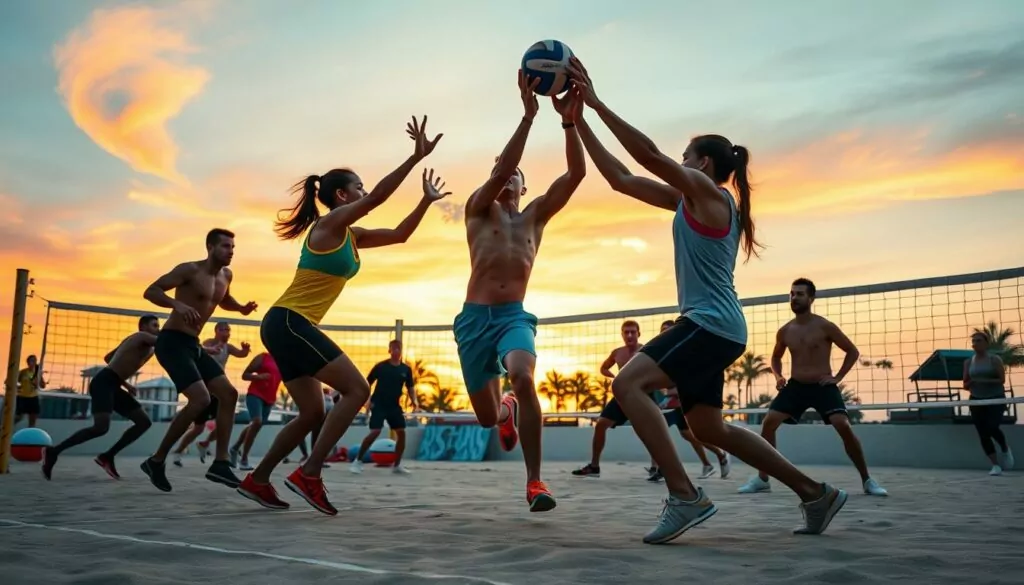
Essential Physical Attributes for Volleyball Players
Volleyball is a fast-paced sport that requires specific physical traits. Players need muscular strength, explosive power, agility, and good cardiovascular health. These skills, improved through specific training, help athletes stand out and perform at their best.
Muscular strength is key for powerful spikes and blocks, which are vital for both offense and defense. Explosive power, gained from plyometric exercises, helps players jump high and move quickly. This is essential for dominating the net. Agility and quick footwork are also important, allowing players to swiftly change direction and position themselves well to handle the ball. Lastly, strong cardiovascular health is needed to keep up with the game’s intense pace, ensuring players stay strong throughout.
| Physical Attribute | Importance for Volleyball | Relevant Training Exercises |
|---|---|---|
| Muscular Strength | Generates power for spikes and blocks | Weight training, resistance exercises |
| Explosive Power | Enables high jumps and quick movements | Plyometrics, Olympic-style lifting |
| Agility and Footwork | Allows rapid changes of direction | Ladder drills, cone drills, speed training |
| Cardiovascular Endurance | Sustains high-intensity play | Interval training, long-duration cardio |
By focusing on these key physical attributes, volleyball players can gain a big advantage on the court. This positions them for success in the sport.
Strength Training Exercises for Volleyball
As a volleyball player, adding strength training to your routine is key. It boosts your game performance. Focus on exercises that work your legs, core, and upper body for explosive moves.
The squat is a must for building lower body strength and power for jumping. Lunges improve single-leg strength and balance, helping setters stay agile. Deadlifts strengthen the back, boosting overall power and stability.
Plyometric exercises like box jumps enhance vertical jump, vital for quick movements. Core exercises, such as medicine ball throws, improve setting accuracy and power.
Agility and plyometric drills boost foot speed and explosive power. Drills like cone runs and depth jumps are great for these skills.
Don’t forget flexibility and mobility exercises. They reduce muscle strains and improve performance. Foam rolling helps with muscle recovery and soreness.
A balanced strength training program, along with agility, flexibility, and recovery, unlocks a player’s full power.
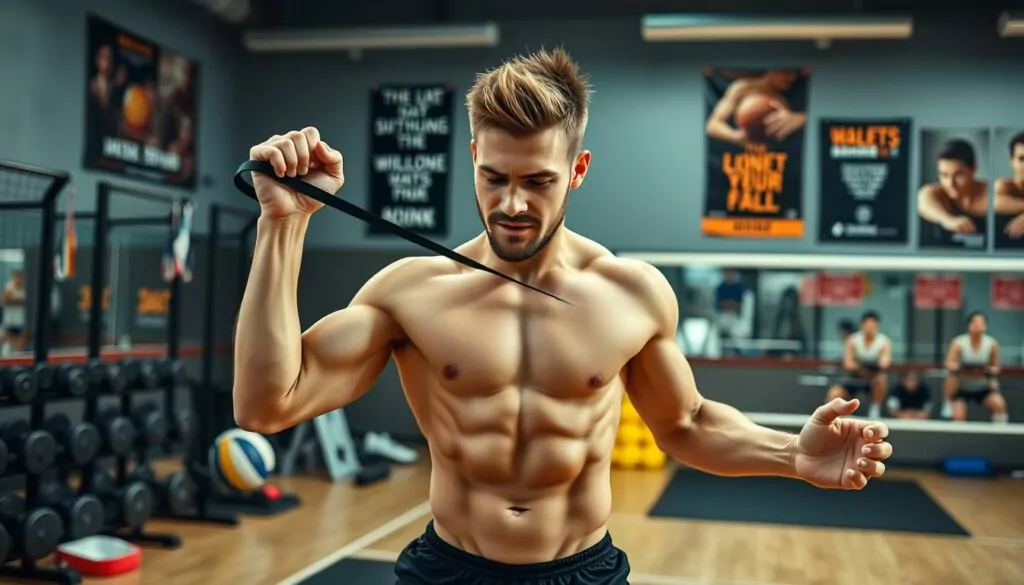
The Importance of Strength Training for Setters
Setters are key in volleyball, setting up the game for hitters. They also lead the team, calling plays and keeping everyone in sync.
Setters need strong core, stable shoulders, and powerful legs for their role. Exercises like planks, squats, and plyometrics help build these skills.
Flexibility and mobility are also vital for setters. Yoga and dynamic stretching keep them performing well. Specialized training tools enhance their skills and decision-making.
With a solid strength and conditioning program, setters can excel and lead their team to win.
“Strength training is not just about building muscle; it’s about developing the physical attributes that enable you to perform at your best on the court.” – John Doe, Volleyball Strength and Conditioning Coach
Plyometric Workouts for Explosive Power
In volleyball, plyometric training is a big deal for athletes wanting to boost their power and play better. Setters need to be precise and accurate to help their teammates attack well. They make quick decisions, read the defense, and pick the best plays fast.
Setters must be flexible to fit different game plans and player styles. Good communication helps them work well with teammates. They also need to know where everyone is on the court to play well.
Being able to move quickly is key for setters to cover the court and react fast. They need to jump high for powerful sets and to help defend the net. Quick and agile footwork lets them move smoothly and stay in position.
Plyometric exercises like squat jumps and box jumps help volleyball players get better at these skills. These exercises use muscle elasticity to build power. Power is about doing work quickly, and fast movements are more powerful.
Power is important in many sports, including volleyball, basketball, and tennis. Plyometric workouts help build fast-twitch muscles for more strength. They also make you burn more calories after working out.
Power training improves reaction times, helping athletes and seniors move better. Mixing strength training with plyometrics boosts power even more. Plyometric exercises focus on quick, powerful movements to enhance power.
Customizing plyometric exercises for your goals is important for a good workout plan. Doing plyometric exercises a few times a week can improve power in all major muscles.
Volleyball athletes can reach their full power by adding plyometric workouts to their training. This helps everyone, from setters to hitters, perform at their best.

Plyometric training is a key part of a good volleyball fitness program. It helps athletes develop the explosive power needed for the sport’s fast-paced movements and intense plays.
“Plyometric exercises are a game-changer for volleyball players looking to take their performance to the next level. The explosive power and rapid movements developed through these workouts are essential for executing powerful serves, blocks, and spikes on the court.”
Agility and Footwork Drills for Volleyball
Agility and footwork are key for volleyball players. They help players move fast, react quickly, and position themselves well. Agility drills, like ladder and cone drills, challenge players to move quickly and precisely. Footwork exercises, such as lateral shuffles, help players move efficiently on the court. Adding these drills to your training can boost your court awareness and reaction time.
The passing ladder drill improves hand-eye coordination and lateral movement. The shuffle and pass drill builds endurance by keeping players moving at a good pace. The drill to serve the ball into different zones focuses on aim and accuracy.
The sprint to serve drill emphasizes endurance. The run and serve drill teaches power by aiming to hit tape markings. The squat and attack drill highlights explosiveness for hitting the ball.
The approach and spike drill improves strategy and footwork for spiking. The swing block drill enhances footwork for swing blocks. The side-to-side blocking drill aims to improve agility in blocking.
The tape target jumping drill improves jump height. The box jump drill teaches explosiveness by jumping into a foam box. The resistance band shuffle drill helps maintain speed and power with lateral movements.
Different serves in volleyball include topspin, float, and jump serves. To pass well, position your body parallel to the net and keep steady. Mastering setting involves a soft touch and precise hand placement.
Effective hitting requires timing, footwork, and arm swing mechanics. Agility and anticipation are key for strong defense.
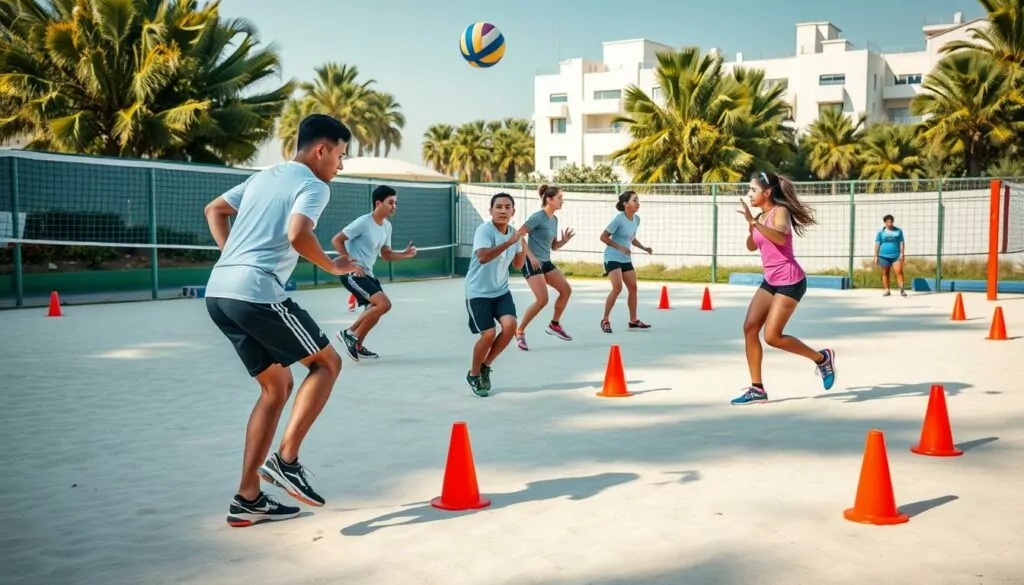
Adding various agility and footwork drills to your training can improve your speed and court awareness. By practicing these drills, you’ll master the dynamic movements needed for volleyball success.
Cardiovascular Conditioning for Endurance
Volleyball is a high-intensity sport that demands players to sustain their efforts throughout the entire match. Developing a robust cardiovascular foundation is key for volleyball athletes. It helps them maintain performance levels and recover quickly between rallies. Running, cycling, or swimming can improve a player’s endurance and recovery.
Interval training and high-intensity interval training (HIIT) are great for volleyball players. These methods involve short, intense bursts of exercise followed by brief rest periods. They enhance a player’s anaerobic capacity and overall cardiovascular fitness.
To improve endurance and agility, volleyball players can do interval sprints. They sprint for 30-60 feet, then rest for 10-20 seconds. This is repeated for 6-10 reps. Plyometric exercises like hurdle hops and jump squats also help with power endurance. They involve 3-5 seconds of activity followed by brief rests. Agility drills that mimic volleyball movements are effective for building endurance and improving agility.
When designing cardiovascular conditioning programs, safety and injury prevention are key. Start each session with a dynamic warm-up routine to prepare muscles and joints. Maintaining proper form and technique is essential to avoid injuries. If players experience pain or discomfort, they should take breaks and consult healthcare professionals.
| Metric | Junior Elite | Senior Elite | Local |
|---|---|---|---|
| Vertical Jump Height | Yusuke et al. (2018), Villalobos et al. (2018) | Ahmad & Ahmad (2019), Rincón et al. (2019) | Annía et al. (2019) |
| Spike Jump Height | Yusuke et al. (2018), Villalobos et al. (2018) | Ahmad & Ahmad (2019), Rincón et al. (2019) | Annía et al. (2019) |
| Cardiorespiratory Capacity | 47.76 ml/kg/min | 45.54 ml/kg/min | 36.48 ml/kg/min |
| Arm Strength | Grgantov et al. (2013), Koley & Kaur (2011) | Ahmad & Ahmad (2018) | – |
| Spike Velocity | – | Yulanda & Sepdanius (2019) | – |
The LA84 Foundation has supported and expanded youth sports in Southern California. Over $156 million has been committed to these efforts. This has benefited more than two million boys and girls, as well as over 1,000 youth sports organizations. The foundation’s Coaching Program offers educational workshops. Its Volleyball Coaching Manual, copyrighted from 2001 to 2012, covers coaching-related topics.

“Prioritizing cardiovascular conditioning is essential for volleyball players to maintain their performance levels and recover quickly between rallies. By incorporating a diverse range of aerobic exercises and high-intensity interval training, players can build the endurance and agility needed to excel on the court.”
Flexibility and Mobility Exercises for Injury Prevention
For volleyball players, keeping muscles flexible and mobile is key to staying injury-free and playing well. Stretching exercises focus on big muscle groups like hips, hamstrings, and shoulders. This helps improve movement and lowers the chance of muscle pulls or tears. Mobility drills also boost joint stability and control, making volleyball moves smoother and more efficient.
Adding flexibility and mobility exercises to training can keep players healthy all season. This includes stretching, foam rolling, and dynamic warmups to keep joints moving right. By focusing on these areas, players can dodge common injuries like shoulder problems, knee pain, and ankle sprains.
- Shoulder mobility drills to improve overhead range of motion
- Hip flexor and quadriceps stretches to maintain proper pelvic alignment
- Calf and Achilles tendon stretches to prevent ankle injuries
- Thoracic spine mobility exercises to enhance rotational power
| Exercise | Benefits | Muscles Targeted |
|---|---|---|
| Downward Dog Pose | Improves shoulder, hamstring, and calf flexibility | Shoulders, hamstrings, calves |
| Lateral Lunge with Reach | Enhances hip and groin mobility | Hips, groin |
| Wall Angels | Increases thoracic spine mobility and shoulder range of motion | Shoulders, upper back |
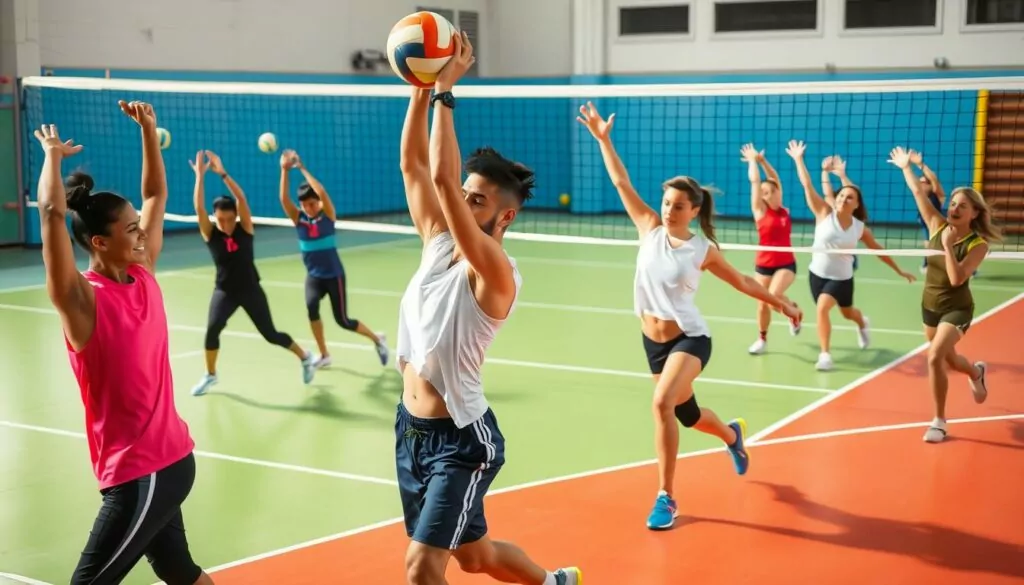
By adding flexibility and mobility exercises to their routine, volleyball players can lower injury risk and reach their best performance.
Off-Season Training Programs for Volleyball Athletes
The off-season is key for volleyball athletes to improve their physical skills. They should focus on strength, plyometrics, agility, and more. This helps them get ready for the season and reduces injury risks.
For example, the Advanced Middle School Camp at SoCal Volleyball Club is for 6th-8th graders. It runs from July 15th to 25th, three days a week. The Advanced High School Tryout Prep Camp is for 9th-12th graders, also from July 15th to 25th, three days a week. These camps help players sharpen their skills for the season.
The off-season also includes specialized training. The Libero & Defensive Specialist Workshop is for middle and high school players. It runs from July 17th to August 2nd, two days a week. The Setter Workshop is for the same age group, also from July 17th to August 2nd, two days a week. It focuses on setting skills and strategy.
Off-season training is vital for staying fit and improving performance. The volleyball program lasts 10 weeks, with workouts 2 to 5 times a week. Each session is about an hour, sometimes 30 minutes. The program has three levels and includes testing and reassessment. Beach volleyball players aim for a vertical jump over 30 inches, and there’s a workout to help with that.
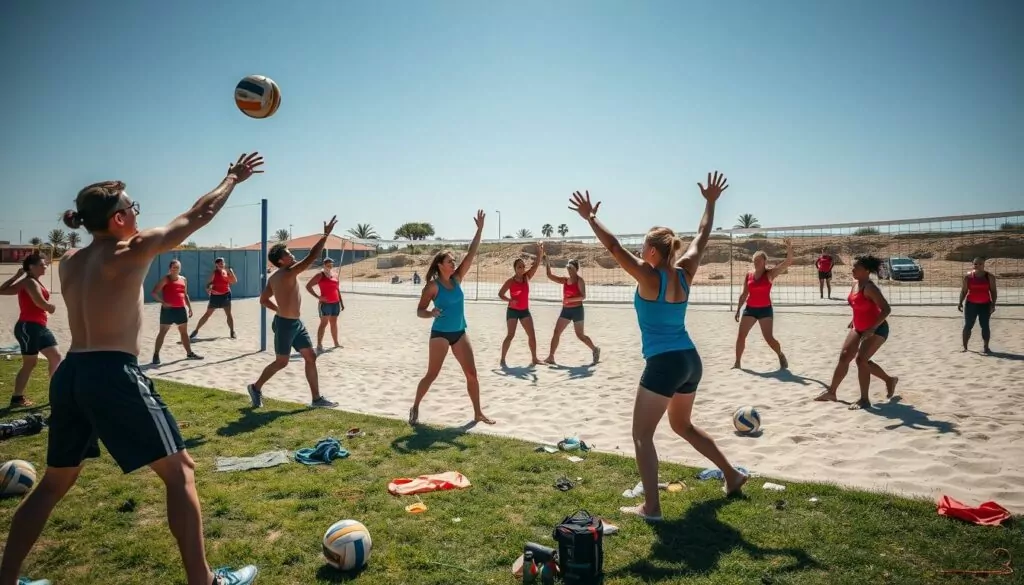
By investing in off-season training, volleyball athletes can set a strong foundation. This prepares them for success when the season starts.
The Psychology of Volleyball: Mental Strategies for Success
Imagine a volleyball player who can consistently deliver pinpoint serves, execute flawless spikes, and make game-changing defensive plays. While these physical skills are undoubtedly impressive, the true secret to their success may lie in their mastery of the mental game. Research shows that athletes who set specific and measurable goals are 90% more likely to achieve success compared to those who do not set goals.
Also, athletes who regularly practice mental imagery and visualization techniques show a 75% improvement in confidence levels and a 60% increase in performance outcomes. The psychology of volleyball is a critical yet often overlooked aspect of the sport. Developing strong mental strategies can be just as important as honing technical and tactical abilities.
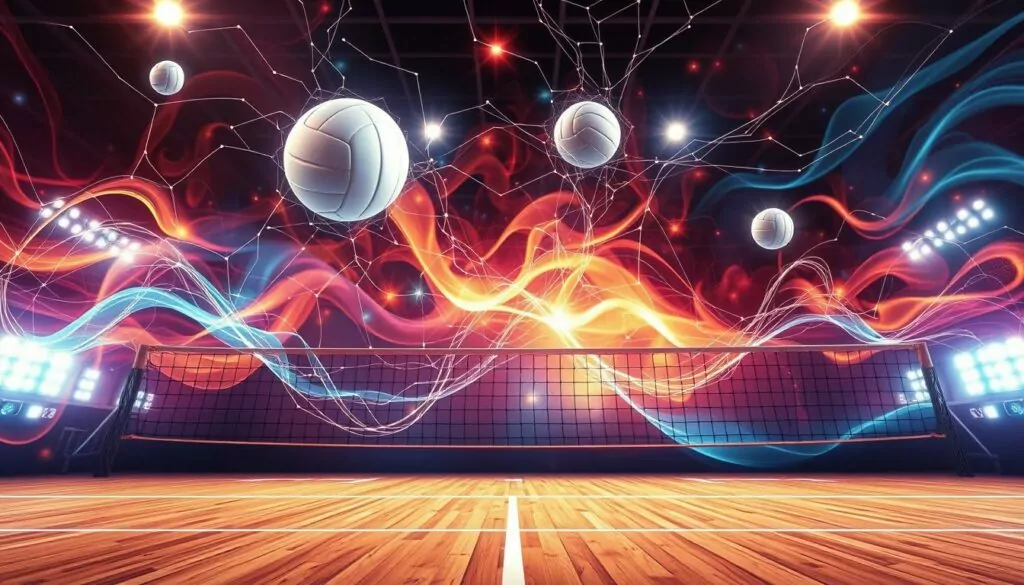
Key Takeaways
- Volleyball is not just a physical sport, but also a mental one
- Developing psychological skills, such as building team cohesion and communication, can contribute to overall success
- Mental toughness, visualization techniques, and effective goal-setting are vital for peak performance
- Managing pressure and anxiety, as well as exhibiting strong leadership, are critical for navigating the competitive landscape
- Incorporating mental training into a volleyball program can help players perform at their best and maintain focus under pressure
Building Team Cohesion and Communication
Volleyball is all about teamwork and talking clearly. Players need to work together and understand each other well. This way, they can move as one and play better together.
Team-building exercises are key to building unity. These activities help players get to know each other and build trust. When teammates trust each other, they can handle tough situations better.
Good communication is vital for a winning team. Players need to talk a lot, both during and outside games. This ensures they know the plan, each other’s skills, and can make quick decisions.
| Strategies for Building Team Cohesion | Importance of Effective Communication |
|---|---|
|
|
By focusing on teamwork and talking, volleyball teams can reach their best. These are the basics for a strong team. They help players work together smoothly and beat their rivals.
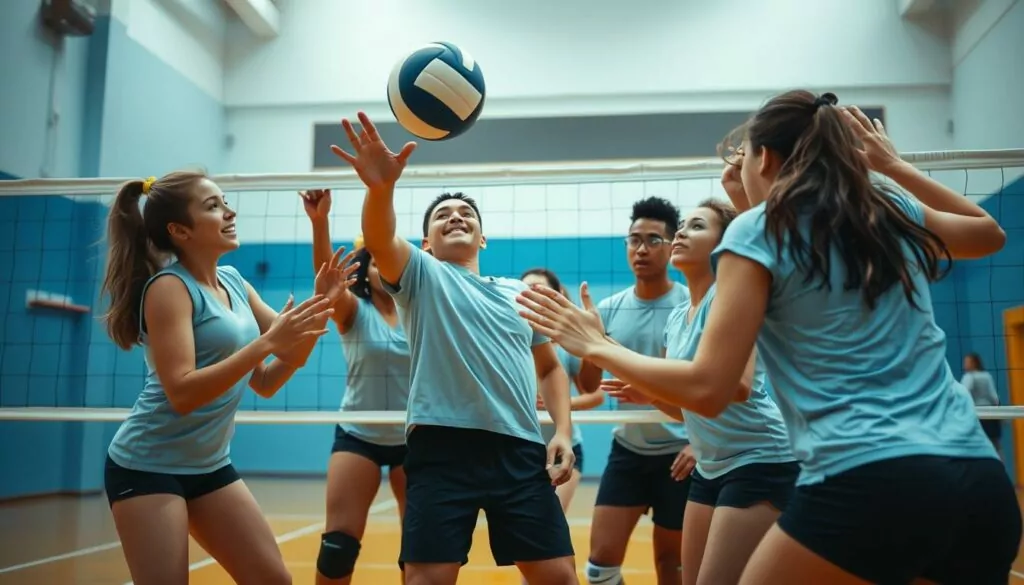
“Teamwork is the ability to work together toward a common vision. The ability to direct individual accomplishments toward organizational objectives. It is the fuel that allows common people to attain uncommon results.”
– Andrew Carnegie
Developing Mental Toughness in Volleyball
Volleyball is a sport that needs a lot of mental strength. Mental toughness helps players deal with tough times, stay focused, and do their best even when it’s hard. It’s very important for female volleyball players in big games and tournaments. It lets them handle pressure and make quick decisions during the game.
Using visualization techniques is a good way to build mental toughness. Players can practice game scenarios in their mind. This helps them get ready for the game’s surprises. Also, positive self-talk can make players more confident and better at the game.
Setting specific, achievable goals helps players get better at volleyball. Having pre-game routines can also help. It makes players feel more ready and focused before games. Deep breathing before a game can also help manage stress.
Mental toughness is key to winning or losing in volleyball. By using strategies like visualization, positive self-talk, setting goals, and pre-game routines, players can improve their mental game.
“Mental toughness is essential for volleyball players to thrive in high-pressure situations and make split-second decisions on the court.”
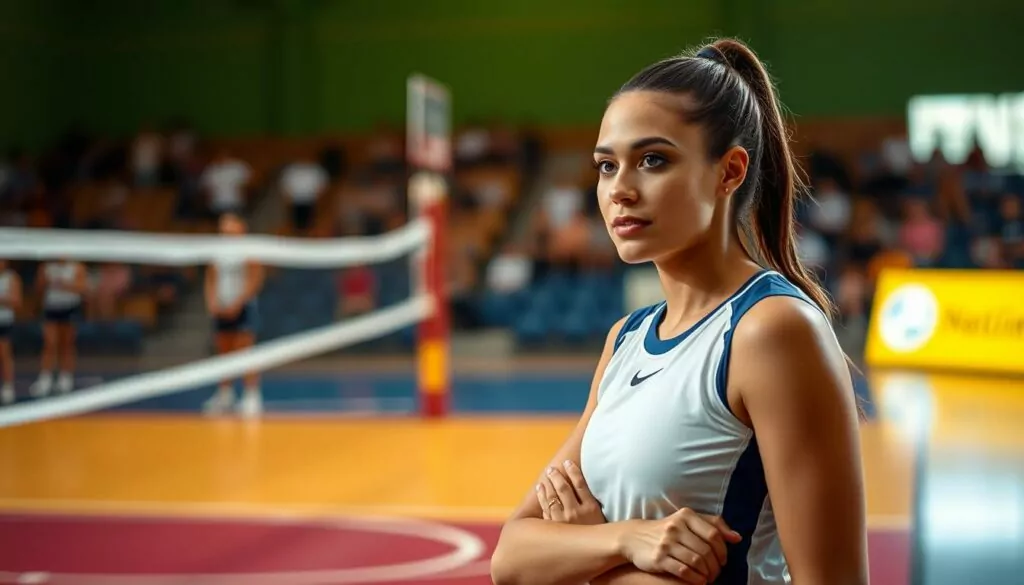
Thinking about how you did after each game helps too. It lets players see what they need to work on and plan for the future. By learning from mistakes and getting better at mental toughness, volleyball players can reach their highest level of success.
Visualization Techniques for Improved Performance
Successful volleyball players and teams often use visualization techniques to enhance their on-court performance. By mentally rehearsing successful serves, spikes, or defensive plays, athletes can build confidence and reduce anxiety. Visualizing the ball striking the court with precision helps players reinforce the neural pathways associated with these skills.
The experiment outlined in the Journal of Applied Physiology identified six unique autonomic nervous system responses that correlate with mental rehearsal in volleyball training. This suggests that visualization can help in the construction of schema that can be reproduced automatically in practice. Dr. David Yukelson of Pennsylvania State University recommends dedicating 10-15 minutes a day to imagery training for improved performance.
Visualization before game competitions can help athletes reflect on the mindset they want to carry into competition and imagine themselves performing with confidence. Integrating visualization into practice for learning new skills, refining old skills, and correcting errors is a recommended technique. Allowing all the senses to play a role in visualization techniques can have tremendous benefits for athletes, as the brain cannot differentiate between something imagined and an activity physically occurring.
Arm Strength, Core Stability, Leg Power, Toss Consistency, Approach and Footwork, Contact Point, Targeting Weak Receivers, Changing Serve Types, Depth Variation, Visualization Techniques, Drills, Strength Training, and Flexibility are all key factors in mastering the volleyball serve. Consistent practice and a focus on these aspects can lead to improved serving performance and greater success on the court.
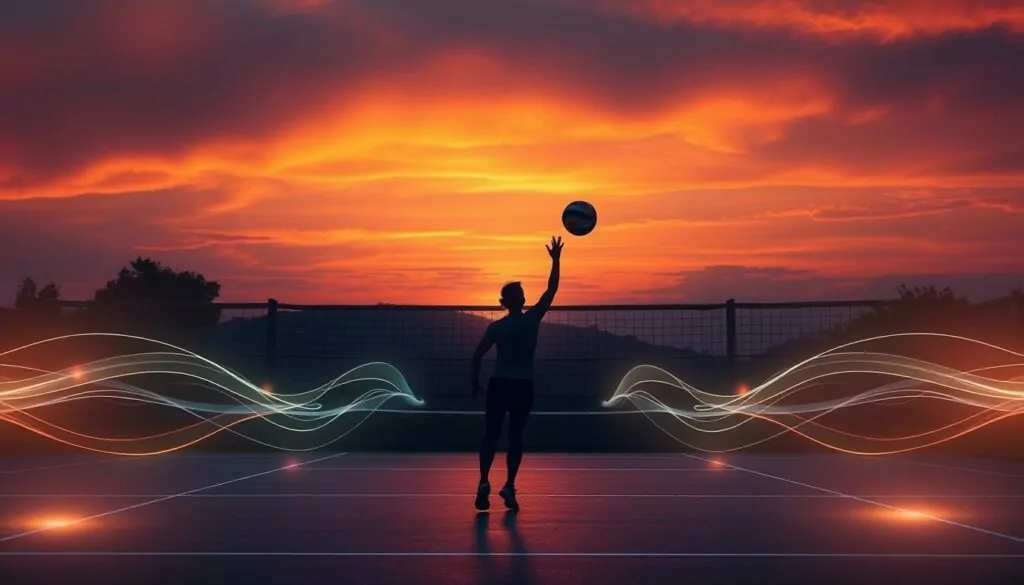
“Visualization is the ability to create an image in your mind and then experience that image as if it were real. It’s a powerful tool that can help athletes improve their performance, build confidence, and overcome mental barriers.”
Managing Pressure and Anxiety During Matches
Volleyball is a high-stakes sport that puts a lot of pressure on players. It’s hard to stay calm and focused under the spotlight, but it’s key for doing well. Research shows that negative thoughts can hurt a player’s game, while positive ones can help. Sports psychologist Jim Loehr points out how important our inner dialogue is to our performance.
Players need to find ways to control their emotions and stay focused during games. Techniques like deep breathing, visualization, and pre-game routines can help. Visualization, when done right, can really boost a player’s game.
Training in high-pressure situations can also prepare athletes for match day. By facing challenges in a safe space, players build confidence and learn to handle pressure better.
Coaches should focus as much on the mental game as on physical training. Teaching players how to handle stress can unlock their full abilities and lead to success on the court.
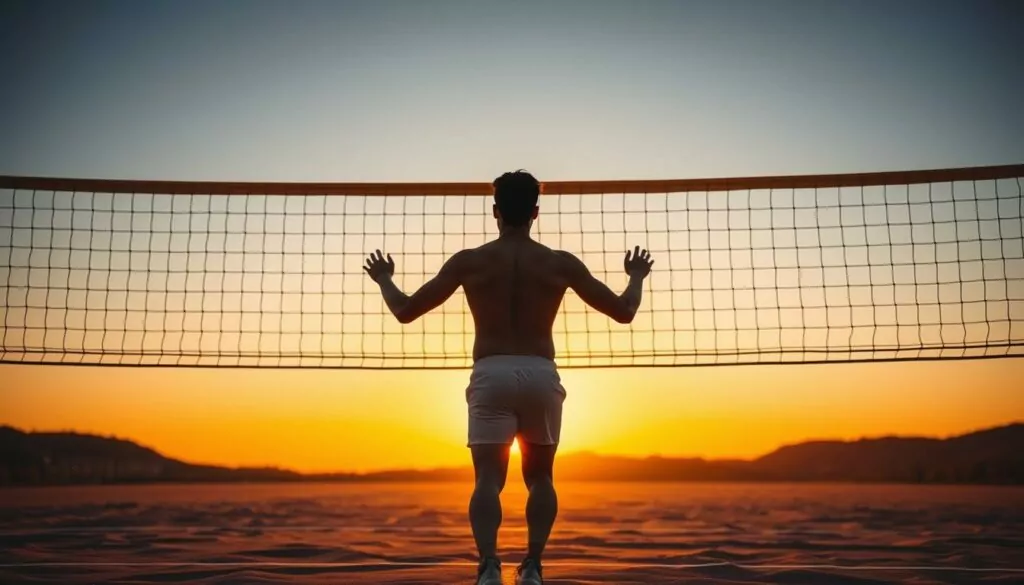
| Coping Strategy | Description | Effectiveness |
|---|---|---|
| Positive self-talk | Replacing negative thoughts with constructive, motivating inner dialogue | Proven to enhance athletic performance, boost resilience, and promote overall mental well-being |
| Visualization | Mentally rehearsing successful match scenarios and desired outcomes | Significantly enhances sports performance when done effectively |
| Deep breathing | Slow, controlled breathing exercises to reduce physiological stress responses | Helps athletes regulate emotions and maintain composure under pressure |
| Pre-match routines | Consistent, structured mental and physical preparation before matches | Promotes focus, confidence, and a sense of control during competition |
By using these strategies in training and during games, volleyball players can better handle stress and improve their performance. A study looked at how elite athletes cope with stress and its impact on their mental health.
“Psychological strain in elite athletes is characterized by perceived stress and difficulty to cope, which can lead to stress-related symptoms.”
Coaches should focus as much on the mental game as on physical training. Teaching players how to manage stress can unlock their full abilities and lead to success on the court.
Goal Setting and Performance Evaluation
Setting goals and evaluating performance are key for a volleyball player’s growth and success. Players can stay motivated and track their progress by setting both short-term and long-term goals. Short-term goals are specific and achievable, while long-term goals are bigger and take longer to achieve.
Reviewing and adjusting goals with coaches and teammates keeps players on track. Looking at match data and getting feedback helps players improve and contribute more to the team. Coaches should use tools to measure skill development and provide feedback.
Reaching goals boosts confidence and motivates players to keep improving. Goal-setting keeps players focused and helps them perform better. A supportive team helps players overcome obstacles in achieving their goals.
VidaVibe Volleyball plans to add more tournaments, introduce new products, and start summer camps in 2024. These goals show the company’s dedication to improving the volleyball experience for everyone.
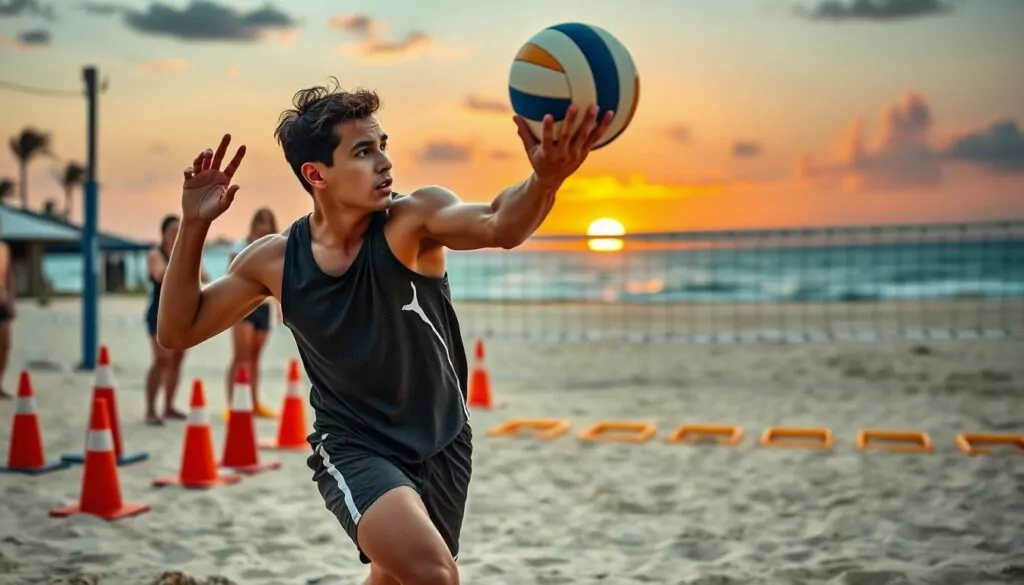
In summary, goal setting and performance evaluation are vital for a volleyball player’s journey. By setting goals, seeking feedback, and having a supportive team, players can reach their full ability and help their team succeed.
Leadership Skills for Volleyball Captains
Volleyball captains are key in building team unity and keeping morale high. They need to communicate well, understand emotions, and motivate others. They should give feedback, solve conflicts, and help plan strategies and games.
Building strong relationships with coaches is vital for captains. Teams with good coach-player relationships keep players longer and perform better. Captains who connect well with coaches can make their team more cohesive and successful.
Captains develop their skills through team-building activities like hiking and goal-setting. These activities help them improve communication, delegate tasks, and motivate their teammates.
Good captains also give feedback and help players improve. Teams that get feedback early in the season do better, and players feel more confident. Captains can help their teammates grow and reach their goals.
In summary, volleyball captains are essential for team success. They build strong relationships, organize team activities, and give feedback. Captains who communicate well, understand emotions, and motivate others lead their teams to victory.
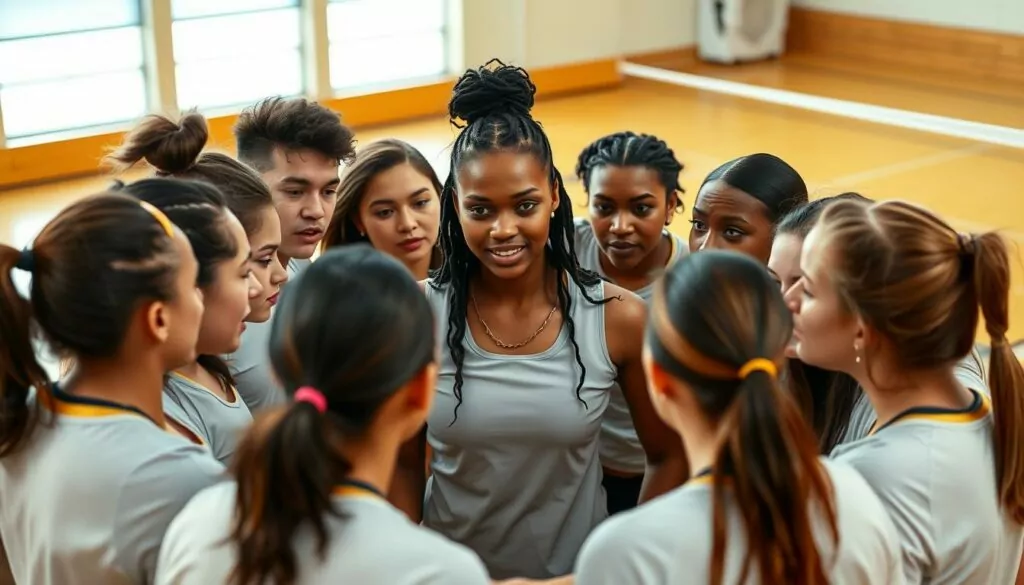
| Key Leadership Skills for Volleyball Captains | Benefits for the Team |
|---|---|
| Clear communication | Improved team coordination and understanding |
| Emotional intelligence | Enhanced team morale and cohesion |
| Ability to motivate teammates | Increased player effort and team performance |
| Conflict resolution skills | Effective problem-solving and team unity |
| Providing constructive feedback | Player development and improved team dynamics |
“The mark of a great captain is the ability to elevate the performance of their teammates, not just their own.” – Unknown
Maintaining Focus and Motivation Throughout the Season
Being a volleyball player means facing tough challenges all season. To keep going, setting small goals can really help. Celebrating each win boosts confidence and shows the team’s progress.
Building a strong team bond off the court makes a big difference. It helps players work better together on the court.
Getting advice from experienced coaches is very valuable. Their feedback can improve skills without hurting confidence. Having clear team goals gives players something to aim for.
Investing in training and good equipment also boosts team performance.
Keeping a positive attitude is key. Building mental strength helps players face challenges without getting discouraged. Techniques like visualization and positive self-talk keep players motivated.
Looking after the mental, emotional, physical, and spiritual sides of the game is vital. This approach keeps players excited and performing well all season.
FAQ
What are the two primary types of serves in volleyball?
Volleyball has two main serves: the underhand and the overhand. The underhand serve is good for beginners. The overhand serve is better for competitive play.
What are the key elements of an effective overhand serve?
A good overhand serve needs a few things. First, the grip and stance are important. The server should hold the ball with one hand and hit it with the other.
The feet should be shoulder-width apart, with one foot slightly forward. The toss should be high to hit the ball at its peak. The contact point should be above the waist, with a strong wrist snap and full arm extension.
What are the different variations of the overhand serve?
There are two main overhand serve types: topspin and float. The topspin serve makes the ball dip and dive. The float serve wobbles in the air, making it hard to pass.
What are the advantages of the jump serve in volleyball?
The jump serve combines a jump with a powerful serve. It can have a flatter trajectory and shorten the distance to the receiver. This adds power and precision to the serve.
How can the float serve be an effective weapon in volleyball?
The float serve is hard to pass because it’s unpredictable. Serve it flat, aiming for the midpoint of the antenna. Focus on speed second. It’s a great way to disrupt the opposing team’s offense.
What are some effective serving strategies in volleyball?
Good serving strategies include targeting weak receivers and varying your serves. Use topspin, float, and different locations. Keep your serve placement consistent. Communicate with your team to help them position themselves.
What are some common serving errors and how can they be avoided?
Common errors include inconsistent tosses and improper contact. To avoid these, practice a consistent routine and master the arm swing. Ensure the toss is at the right height and placement. Practice in game-like scenarios to build muscle memory.
How can serving drills help improve accuracy and power?
Drills that focus on accuracy, consistency, and power can improve your serve. Repetition builds muscle memory and corrects mechanics. Practice in game-like situations to develop mental focus and adaptability.
What are the essential physical attributes for successful volleyball players?
Successful players need strength, explosive power, agility, and endurance. Developing these through training can give you a competitive edge.
How can strength training benefit volleyball players?
Strength training exercises for the legs, core, and upper body build the strength needed for explosive movements. Squats, deadlifts, and core routines are effective for volleyball.
What role do plyometric exercises play in volleyball training?
Plyometric training builds explosive power for jumping, spiking, and blocking. Exercises like squat jumps and box jumps mimic volleyball’s explosive movements.
How can agility and footwork drills improve a volleyball player’s performance?
Agility drills and footwork exercises improve quick movements. Ladder drills and lateral shuffles help with court coverage and reaction time. These drills enhance court awareness and decision-making.
Why is cardiovascular conditioning important for volleyball players?
Volleyball is a high-intensity sport that requires endurance. Aerobic exercise and interval training improve endurance and quick recovery. This helps maintain performance levels throughout the game.
How can flexibility and mobility exercises benefit volleyball players?
Flexibility and mobility exercises prevent injuries and improve performance. Stretching and mobility drills target major muscle groups and joints. This enhances range of motion and makes volleyball movements easier and more efficient.
What should volleyball athletes focus on during the off-season?
The off-season is for holistic physical development. Focus on strength, plyometrics, agility, and endurance. This preparation reduces injury risk and prepares you for peak performance during the season.
How can building team cohesion and communication benefit a volleyball team?
Strong bonds and communication are key for success. Team-building exercises, open dialogue, and a supportive environment foster trust and understanding. This allows the team to perform better together.
What role does mental toughness play in volleyball success?
Volleyball demands mental strength. Mental toughness helps players overcome setbacks and stay focused under pressure. Positive self-talk, visualization, and goal-setting can help stay resilient and adaptable.
How can visualization techniques improve volleyball performance?
Visualization enhances performance by mentally rehearsing successful plays. It builds confidence, reduces anxiety, and prepares for game demands. This leads to more consistent execution during matches.
How can volleyball players manage pressure and anxiety during matches?
Managing pressure and anxiety is critical. Use deep breathing, positive self-talk, and pre-match routines to stay calm. These strategies help regulate emotions and stay focused during matches.
Why is effective goal setting and performance evaluation important for volleyball players?
Goal setting and evaluation are vital for growth and success. Set short-term and long-term goals to stay motivated and measure progress. Regularly review and adjust goals to guide training and development.
What are the key responsibilities of a volleyball team captain?
Captains foster unity, maintain morale, and set a positive example. They need leadership skills like clear communication and emotional intelligence. They should provide feedback, resolve conflicts, and help develop strategies.
How can volleyball players maintain focus and motivation throughout the season?
The long season tests mental strength and focus. Set incremental goals, celebrate small wins, and practice positive self-talk. A supportive team environment and self-care practices help sustain performance and enthusiasm.
